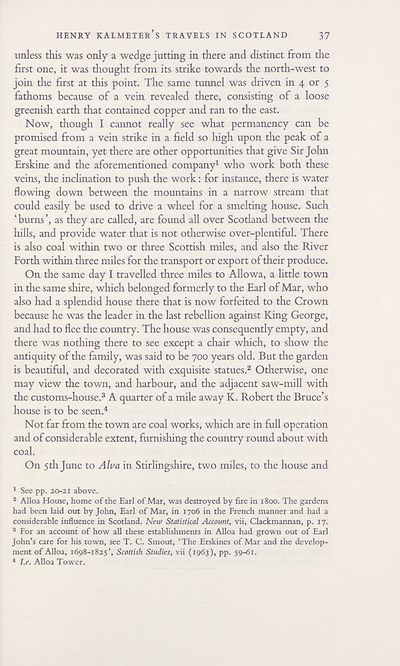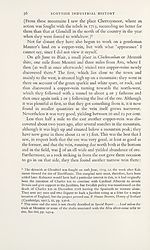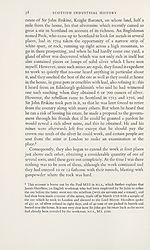Series 4 > Scottish industrial history
(82) Page 37
Download files
Complete book:
Individual page:
Thumbnail gallery: Grid view | List view

HENRY KALMETER’S TRAVELS IN SCOTLAND 37
unless this was only a wedge jutting in there and distinct from the
first one, it was thought from its strike towards the north-west to
join the first at this point. The same tunnel was driven in 4 or 5
fathoms because of a vein revealed there, consisting of a loose
greenish earth that contained copper and ran to the east.
Now, though I cannot really see what permanency can be
promised from a vein strike in a field so high upon the peak of a
great mountain, yet there are other opportunities that give Sir John
Erskine and the aforementioned company1 who work both these
veins, the inclination to push the work: for instance, there is water
flowing down between the mountains in a narrow stream that
could easily be used to drive a wheel for a smelting house. Such
‘ burns ’, as they are called, are found all over Scotland between the
hills, and provide water that is not otherwise over-plentiful. There
is also coal within two or three Scottish miles, and also the River
Forth within three miles for the transport or export of their produce.
On the same day I travelled three miles to Allowa, a little town
in the same shire, which belonged formerly to the Earl of Mar, who
also had a splendid house there that is now forfeited to the Crown
because he was the leader in the last rebellion against King George,
and had to flee the country. The house was consequently empty, and
there was nothing there to see except a chair which, to show the
antiquity of the family, was said to be 700 years old. But the garden
is beautiful, and decorated with exquisite statues.2 Otherwise, one
may view the town, and harbour, and the adjacent saw-mill with
the customs-house.3 A quarter of a mile away K. Robert the Bruce’s
house is to be seen.4
Not far from the town are coal works, which are in full operation
and of considerable extent, furnishing the country round about with
coal.
On 5th June to Alva in Stirlingshire, two miles, to the house and
1 See pp. 20-21 above.
2 Alloa House, home of the Earl of Mar, was destroyed by fire in 1800. The gardens
had been laid out by John, Earl of Mar, in 1706 in the French manner and had a
considerable influence in Scotland. New Statistical Account, vii, Clackmannan, p. 17.
3 For an account of how all these establishments in Alloa had grown out of Earl
John’s care for his town, see T. C. Smout, ‘The Erskines of Mar and the develop¬
ment of Alloa, 1698-1825’, Scottish Studies, vii (1963), pp. 59-61.
4 I.e. Alloa Tower.
unless this was only a wedge jutting in there and distinct from the
first one, it was thought from its strike towards the north-west to
join the first at this point. The same tunnel was driven in 4 or 5
fathoms because of a vein revealed there, consisting of a loose
greenish earth that contained copper and ran to the east.
Now, though I cannot really see what permanency can be
promised from a vein strike in a field so high upon the peak of a
great mountain, yet there are other opportunities that give Sir John
Erskine and the aforementioned company1 who work both these
veins, the inclination to push the work: for instance, there is water
flowing down between the mountains in a narrow stream that
could easily be used to drive a wheel for a smelting house. Such
‘ burns ’, as they are called, are found all over Scotland between the
hills, and provide water that is not otherwise over-plentiful. There
is also coal within two or three Scottish miles, and also the River
Forth within three miles for the transport or export of their produce.
On the same day I travelled three miles to Allowa, a little town
in the same shire, which belonged formerly to the Earl of Mar, who
also had a splendid house there that is now forfeited to the Crown
because he was the leader in the last rebellion against King George,
and had to flee the country. The house was consequently empty, and
there was nothing there to see except a chair which, to show the
antiquity of the family, was said to be 700 years old. But the garden
is beautiful, and decorated with exquisite statues.2 Otherwise, one
may view the town, and harbour, and the adjacent saw-mill with
the customs-house.3 A quarter of a mile away K. Robert the Bruce’s
house is to be seen.4
Not far from the town are coal works, which are in full operation
and of considerable extent, furnishing the country round about with
coal.
On 5th June to Alva in Stirlingshire, two miles, to the house and
1 See pp. 20-21 above.
2 Alloa House, home of the Earl of Mar, was destroyed by fire in 1800. The gardens
had been laid out by John, Earl of Mar, in 1706 in the French manner and had a
considerable influence in Scotland. New Statistical Account, vii, Clackmannan, p. 17.
3 For an account of how all these establishments in Alloa had grown out of Earl
John’s care for his town, see T. C. Smout, ‘The Erskines of Mar and the develop¬
ment of Alloa, 1698-1825’, Scottish Studies, vii (1963), pp. 59-61.
4 I.e. Alloa Tower.
Set display mode to:
![]() Universal Viewer |
Universal Viewer | ![]() Mirador |
Large image | Transcription
Mirador |
Large image | Transcription
Images and transcriptions on this page, including medium image downloads, may be used under the Creative Commons Attribution 4.0 International Licence unless otherwise stated. ![]()
| Scottish History Society volumes > Series 4 > Scottish industrial history > (82) Page 37 |
|---|
| Permanent URL | https://digital.nls.uk/126655995 |
|---|
| Description | Over 180 volumes, published by the Scottish History Society, containing original sources on Scotland's history and people. With a wide range of subjects, the books collectively cover all periods from the 12th to 20th centuries, and reflect changing trends in Scottish history. Sources are accompanied by scholarly interpretation, references and bibliographies. Volumes are usually published annually, and more digitised volumes will be added as they become available. |
|---|


